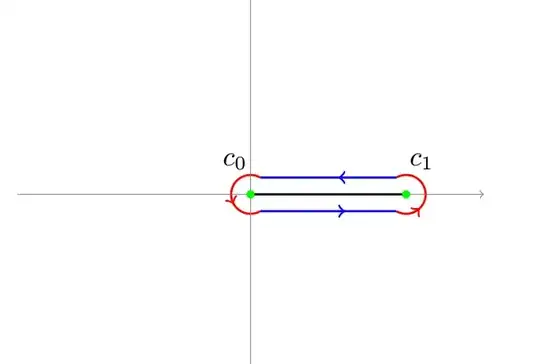I'm currently working on the integral $I = \int_0^1 \sqrt\frac{1-x}{x}dx$. I would like to evaluate it with the dogbone contour specifically. Here's what I did so far:
Denote $f(z) = \sqrt\frac{1-z}{z}$ the integrand function (with complex variable). Then I observe that $$f(z) = (1 - z)^{\frac{1}{2}}z^{-\frac{1}{2}} = \frac{|1 - z|^{\frac{1}{2}}}{|z|^{\frac{1}{2}}}e^{\frac{1}{2}i(\arg(z) - \arg(1 - z))} (*)$$
Since $\ln(z) = \ln(|z|) + i\arg(z)$ (and similarly $\ln(1 - z) = \ln(|1 - z|) + i\arg(1 - z)$). Denote $Arg = \frac{1}{2}(\arg(z) - \arg(1 - z))$ for the step to come.
Next I defined $- \pi < \arg(z) \leq \pi$ and $0 \leq \arg(z) < 2\pi$, to observe the behaviour of Arg in the intervals $(- \infty, 0)$ and $(0,1)$.
In $(- \infty, 0)$, from above, we have: $\arg(z) \to \pi$, $\arg(1 - z) \to 2\pi \implies Arg \to \frac{1}{2}(\pi - 2\pi) = - \frac{\pi}{2}$
In $(- \infty, 0)$, from below, we have: $\arg(z) \to - \pi$, $\arg(1 - z) \to 0 \implies Arg \to \frac{1}{2}(- \pi - 0) = - \frac{\pi}{2}$
Hence we deduce that our function is continuous everywhere on this interval. However:
In $(0,1)$, from above, we have: $\arg(z) \to 0$, $\arg(1 - z) \to 2\pi \implies Arg \to \frac{1}{2}(0 - 2\pi) = - \pi$
In $(0,1)$, from below, we have: $\arg(z) \to 0$, $\arg(1 - z) \to 0 \implies Arg \to 0$
And in this interval our function is discontinuous since $e^{- i\pi} \ne e^0 = 1$. Thus I introduced a dogbone contour, namely $C$, aroud the branch $[0,1]$ such that:
$$C = \psi_1 \cup \psi_2 \cup c_0 \cup c_1$$
Where $\psi_1$ is the blue segment from $1$ to $0$ and $\psi_2$ is the blue segment from $0$ to $1$. (Thanks to @Zaid Alyafeai for the picture).
Then we have the equality: $\oint_C f(z)dz = \int_{\psi_1} f(z)dz + \int_{\psi_2} f(z)dz + \int_{c_1} f(z)dz + \int_{c_2} f(z)dz$; and pumping up $C$ we also have that $\oint_C = - 2\pi i (res_{z = 0}f(z)dz + res_{z = \infty}f(z)dz)$ by Cauchy Residue Theorem since $0,\infty$ are the only singular points of $f(z)$.
Then I computed them:
For $\int_{\psi_1} f(z)dz$ and $\int_{\psi_2} f(z)dz$, I used $z = t + i\epsilon$ with $t \in [0,1] $and $dz = dt$:
- $$\int_{\psi_1}f(z)dz = - \int_0^1\frac{(1 - t - i\epsilon)^{\frac{1}{2}}}{(t + i\epsilon)^{\frac{1}{2}}}dt = - \int_0^1 \frac{|1 - t - i\epsilon|^{\frac{1}{2}}}{|t + i\epsilon|^{\frac{1}{2}}}e^{i\pi}dt$$ (I deduced the last integral from $(*)$ and from the arguments I computed above)
Then taking the limt when $\epsilon \to 0$ I finally obtained that $\lim\limits_{\epsilon \to 0} \int_{\psi_1}f(z)dz = I$.
- In a very similar way I found that $\lim\limits_{\epsilon \to 0} \int_{\psi_2}f(z)dz = I$ as well.
Now for $\int_{c_0} f(z)dz$ and $\int_{c_1} f(z)dz$, I used $z = \epsilon e^{i\theta}$ with $\theta \in [0,2\pi]$ and $dz = i\epsilon e^{i\theta}$, and my goal was to find upper bounds of the absolute value of these integrals:
- $|\int_{c_0} f(z)dz| = |i\epsilon^{\frac{1}{2}}\int_0^{2\pi}(1 - \epsilon e^{i\theta})^{\frac{1}{2}}e^{\frac{1}{2}i\theta}dt| \leq i\epsilon^{\frac{1}{2}}\int_0^{2\pi}|1 - \epsilon e^{i\theta}|^{\frac{1}{2}}|e^{\frac{1}{2}i\theta}|dt \leq i\epsilon^{\frac{1}{2}}(1 + \epsilon)^{\frac{1}{2}}2\pi$
Thus I had: $0 \leq \lim\limits_{\epsilon \to 0}|\int_{c_0}f(z)dz[ \leq 0$ which implies that $\lim\limits_{\epsilon \to 0}\int_{c_0}f(z)dz = 0$.
In a very similar way again, I found that $\lim\limits_{\epsilon \to 0}\int_{c_1}f(z)dz = 0$.
Hence in the end I had: $\oint_Cf(z)dz = I + I + 0 + 0 = 2I$, and since I also had that $\oint_Cf(z)dz = - 2\pi i (res_{z = 0}f(z)dz + res_{z = \infty}f(z)dz)$, it follows that:
$$2I = - 2\pi i (res_{z = 0}f(z)dz + res_{z = \infty}f(z)dz) (***)$$
And that's where my problem starts (or not !): I computed both residues and found they were both equal to 0, but this implies that $I = 0$ and I feel like this is wrong, because first I don't understand why they would be 0 when looking at their shape, and second this means the "number" of $I$ on the LHS of $(***)$ does not influence our result. So I hope you can help me either finding my mistake, either to show me that those residues are not 0 because I did not achieve to find another result (either to prove me that $I = 0$ because I don't think so).
I already appreciated your time, but any help would be welcome!
